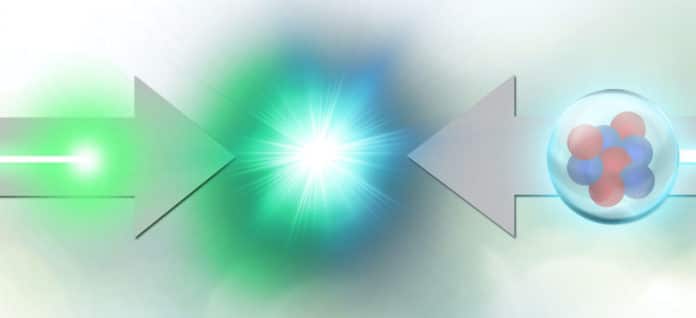Both protons and neutrons at the center of atoms make up the matter we see. Their collective name is nucleons.
In a new study, Dien Nguyen and Jennifer Rittenhouse West invented a method to understand neutron spin. They hope their method could be used at the future Electron-Ion Collider (EIC).
Neutron spin is an inherent property of particles that describes the particles’ internal angular momenta.
Rittenhouse West said, “In addition to studying these things for curiosity, the fact is that nucleon spin must be precisely understood to understand other experiments, very high-energy processes, and even atomic physics. The spin of the neutron needs to be pinned down to study these other puzzles.”
Each neutron is made of three even tinier spinning particles called quarks and a sea of other particles. The spins of the three main “valence” quarks only account for 25 to 30 percent of a neutron’s total spin.
In nucleons, quarks are held together by gluons. The sea of antiquarks, the antimatter particle of a quark, affects a neutron’s spin as well. The three valance quarks move around each other. This generates so-called orbital angular momentum that influences total spin.
Scientists determined how much each player contributes to a neutron’s total spin. They did so by shooting high-energy electrons at them.
When an electron enters a neutron and collides with one of its quarks, the electron is deflected. Measuring it can provide a picture of what’s happening inside the neutron.
However, its short life in nature makes it challenging to measure neutron’s properties.
Nguyen, Rittenhouse West, and their team figured out how to better measure a neutron’s properties.
Nguyen, a Nathan Isgur Postdoctoral Fellow in Nuclear Experiment at Jefferson Lab and an experimental physicist on the project, said, “The unique part of this project is that we were able to model a new way to isolate the neutron. We came up with the idea that uses the features of the new facility to separate the information about the neutron from the nuclei.”
Scientists came up with an idea to isolate new information about the neutron’s spin from experimental data. In the future experiment, the team proposes colliding an electron beam with an ion beam of helium-3, which contains two protons and one neutron in its nucleus. The special detection region will pick up measurements of the two protons from the helium-3 nucleus, a process called double-tagging. This double-tagging of the two protons from a helium-3 nucleus allows the team unhindered access to the now sole remaining particle of the helium-3 nucleus, its neutron.
Nguyen said, “This will provide an “effectively free neutron” target that is not readily available in nature or at existing experimental facilities.”
“This novel technique will give a much more precise measurement to understand the structure of neutron spin. Previous techniques require many different corrections to extract the neutron information. Those corrections introduce a large uncertainty.”
Rittenhouse West said, “When we make these corrections, which are models that have some assumptions baked into them, our error bars get bigger. The more modeling we can avoid, the more the error bars get narrower and narrower for those spin structure observables.”
The unprecedented capabilities of the EIC will provide opportunities for new measurements like this alternative approach to neutron spin.
Journal Reference:
- J. Rittenhouse West et al. Neutron spin structure from e-3He scattering with double spectator tagging at the electron-ion collider. DOI: 10.1016/j.physletb.2021.136726
